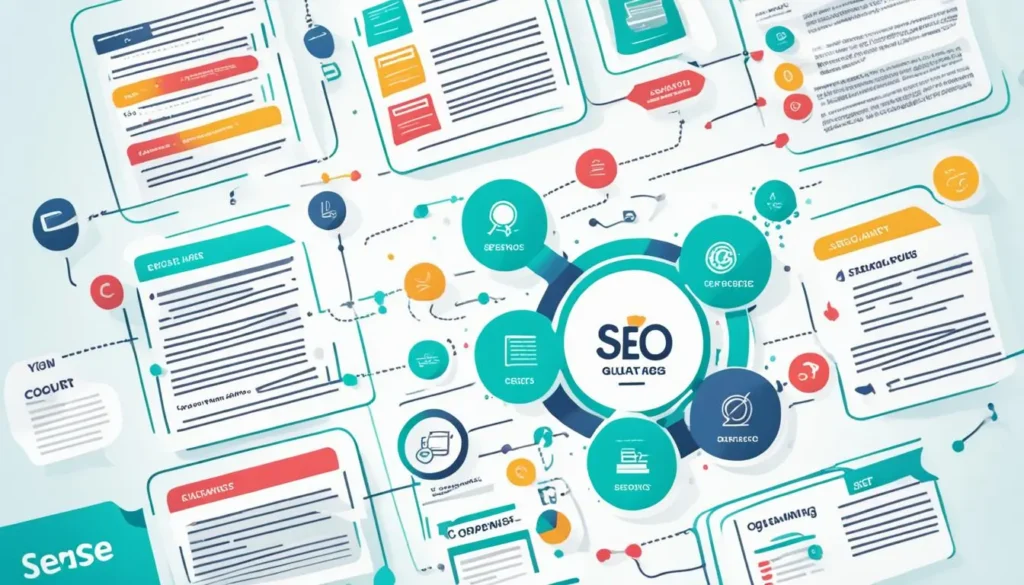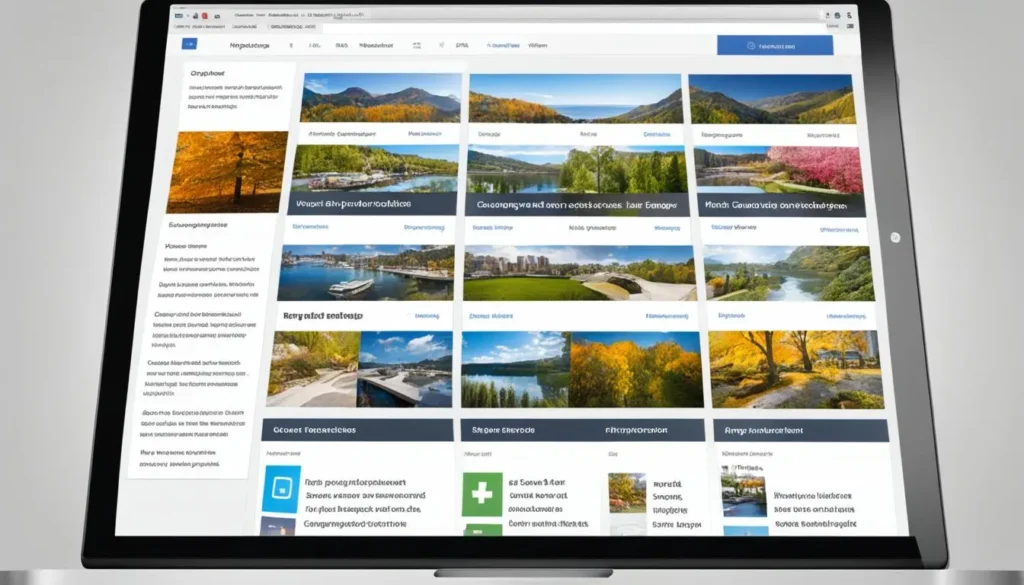Wondered why some sites are at the Google top while others aren’t seen? The secret is SEO, or Search Engine Optimization. Think of SEO as a hero. It helps sites shine in the busy online world1. It does this by making titles, meta tags, and URLs easy for Google to understand1.
But SEO isn’t just for robots. It makes a site easy to use for people, too1. In today’s fast-changing digital world, a strong SEO strategy mixes great content with smart social media use. This combo makes sites more visible and popular1.
Good SEO is more than just using the right words. It also uses tools like Google Analytics. These tools help site owners understand visitors better. They help make marketing online more effective1. So, SEO is the unseen hero of web success.
Key Takeaways
- Strong SEO makes sites more visible and popular through searches1.
- Using the right titles, tags, and URLs helps search engines know what a page is about1.
- SEO’s main aim is to make sites easy and fun to use for visitors1.
- SEO uses content, social media, and data to work better together1.
- By using SEO basics and tools like Google Analytics, you can improve how you market online1.
Demystifying SEO: A Primer for Beginners
Starting in digital marketing means you must grasp how SEO works. This is essential for your journey to success. SEO meaning is all about making your website more visible and authoritative to search engines. You do this by using SEO techniques to enhance your site’s structure and content. You want to meet search engines’ high standards.2
The top benefits of SEO are more website visitors and better interaction with users. This is key for any business or personal brand on the rise2. A solid SEO plan will draw the right crowd to your web home. It also ensures they find engaging, helpful content. This encourages them to come back.
To get SEO right, start with the simple stuff. Make your site load fast and easily viewable on mobile devices. Did you know, websites that load in under 2 seconds keep visitors around better2? Also, keep image sizes small, under 500KB. This will make your site faster and more enjoyable to use2.
| SEO Factor | Recommended Strategy | Benefit |
|---|---|---|
| Load Time | Optimize images and minify CSS/JS | Improved user experience and SEO ranking2 |
| Content Quality | Regular, high-quality updates | Increased traffic and engagement3 |
| Internal Links | Use strategically to improve navigation | Enhanced SEO and user experience3 |
| Mobile Optimization | Responsive design | Greater accessibility and reach2 |
Using tools like Google Site Kit and Yoast SEO is also crucial. They can help you optimize your content. These tools track your rankings and guide you in attracting and keeping visitors2.
To wrap it up, grasping and using SEO effectively starts with understanding search engines. Know the benefits of SEO and put basic SEO techniques into play. With effort and adapting to the digital world, you can up your website’s game and its rank on search engines.
Interpreting Keyword Density in Modern SEO
The importance of keyword density is still high in SEO. But, understanding it well is key. The focus has now shifted from just using a lot of keywords to how they fit in quality content.
In previous times, SEO pros were all about hitting a keyword density target. They would count how many times a keyword showed up versus the total words. Then, to get a percentage, they would multiply that number by 10045. But, this changed with updates like Google’s Panda4 and Hummingbird4. Now, it’s all about the value of the content and understanding what users really want4.
Today, aiming for about 1-2% keyword density is recommended6. You should definitely avoid keyword stuffing to stay clear of penalties56. It’s more about being smart with your choice of keywords and knowing the user intent56.
| SEO Factor | Description | Impact on SEO |
|---|---|---|
| Keyword Density | Ratio of keyword appearances to total words | Essential for relevance, but overuse can penalize |
| Content Quality | Relevance and value of the text | High-quality content is favored by search engines |
| Search Intent | User’s purpose for searching | Aligning content with intent enhances effectiveness |
In the current SEO landscape, tools for checking keyword density are crucial. Tools like Google Analytics or Semrush’s On-Page SEO Checker are very helpful56. They help in keeping strategies up-to-date. These strategies match user and search engine preferences, promising steady growth.
But, remember, SEO is more than just hitting keyword density rates. At the core, it’s about crafting quality content. The content should be useful, solve problems, and engage readers naturally. Achieving this not only meets SEO targets but also improves the user’s experience.
How Search Engine Algorithms Unravel Content
The way search engines rank content has changed a lot. It’s important to understand these changes. Knowing this helps your website do better in search results. It also keeps your site relevant online.
The Evolution of Search Algorithms
SEO used to be all about using the right keywords enough times. But now, search engines look for the context and usefulness of content. They want to provide what searchers really need. This change is a big step towards a better user experience7.
One key factor for being found online is having a fast website. If your site loads slowly, users might leave. This hurts your visibility and ranking. So, ensuring your website is quick is critical for success8.
Understanding Google’s RankBrain
Google’s RankBrain is a game-changer. It uses artificial intelligence to understand search queries better. By focusing on what users actually want, rather than just keywords, it finds more accurate results. This is called semantic search, where the meaning behind the words matters most7.
Keeping up with these search changes is vital for businesses. They need to create top-notch, optimized content. Today, it’s more about pleasing both users and search algorithms. Your content must be fast, mobile-friendly, and relevant to what people are searching for87.

| Factor | Impact on SEO |
|---|---|
| Website Speed | Improves ranking and user engagement8 |
| Mobile Friendliness | Increases visibility in search results8 |
| High-Quality Backlinks | Enhances credibility and authority of the website8 |
| Content Relevance and Quality | Directly influences rank position and compliance with RankBrain7 |
Dealing with these complex algorithms isn’t just for tech wizards. It’s about making your website count for both search engines and real people. The world of SEO is always changing. We must always be ready to adjust and keep up with new trends.
Decoding Why SEO is Important for Digital Success
SEO is crucial in digital marketing. It boosts a website’s organic search visibility. This makes the foundation for online success stronger. Good SEO helps a website show up more in search results. This is key for companies wanting to attract a searching audience9. SEO is not just about more traffic. It also improves how users experience the site. This leads to more engagement and conversions9.
SEO keeps improving, especially with Google’s changing rules. Staying updated is important for staying ahead and meeting digital marketing goals1011. Better SEO means more organic visitors. It also boosts a brand’s trust by reaching high ranks in searches9. Plus, SEO helps make websites better. It improves things like content, loading speeds, and how well they work on mobile. This means a better experience for users9.
| SEO Component | Impact on Digital Marketing |
|---|---|
| Organic Search Visibility | Increases site accessibility and engagement, leading to higher traffic and potential conversions9. |
| User Experience Optimization | Enhances site interface and functionality which substantially improves user satisfaction and retention rates9. |
| Continuous SEO Adaptation | Keeps the website competitive in rapidly changing search landscapes, preserving relevance and rankings1011. |
SEO is a great investment. It strengthens a company’s online presence. It also provides the tools to succeed in the intense digital market. SEO’s many benefits, from better search visibility to engaging users with great content, are crucial for digital marketing success119.
What is seo: The Core of SEO Basics
SEO is key for making a website more visible online. It involves both creative and technical steps. Understanding these makes your site show up better in searches and more inviting for users.
SEO Definition: A Comprehensive View
Search Engine Optimization, or SEO, works to boost a site’s rank in search results. Google finds new sites on its own and ranks them. If a site follows Google’s guidelines well, it ranks better.
Let’s not forget that most searches are now on mobile. This makes mobile-friendly websites crucial. Such sites load fast on mobile devices and rank higher on search pages.

- Having clear URLs helps users navigate better12.
- Linking your pages well makes your site easier to explore and increases its value13.
- Your content should be better and more helpful than other options out there12.
- Less duplicate content means your users will have a smoother experience and search engines will crawl your site better12.
Organized and valuable content is a win-win. It helps search engines and makes people like your site more. So remember, think about the reader and the search engines when creating your content.
Security is also critical. Adding an SSL/TLS certificate to your site keeps data safe and builds trust with users. Sitemaps are equally important. They help search engines understand your site’s structure, leading to better indexing and findability.
| Element | Impact | Benefit |
|---|---|---|
| Page Speed (Mobile and Desktop) | Ranking Factor | Improves visibility and user experience13 |
| Descriptive URLs | Content Clarity | Easier navigation and understanding of content12 |
| Internal Links | SEO and UX enhancement | Better crawlability and user journey13 |
| Duplicate Content Reduction | Better usage of crawl budget | Enhanced site quality and user satisfaction12 |
SEO involves many steps, all working to make your site better. These range from tech fixes to improving your content. Each step helps make your online home more visible, no matter the changes in tech over time.
Charting Your Path: Strategic SEO Techniques
Diving into strategic SEO means carefully planning and acting. It involves keyword research, bettering content, and linking sites to raise their rankings. The aim is to find a good mix that improves the technical part and the quality of the content.
The method of using Google Suggest for keywords has brought about a focus on long-tail keywords. These are key for standing out in less crowded areas online and getting more attention. Creating solid internal links gives web pages more authority, which helps them rank higher14. Semantic SEO has also changed how we pick and use keywords. Now, we also look for and add related terms to make the content deeper and more relevant to search engines14.
A big part of SEO is meeting search user needs. Methods like the Skyscraper Technique 2.0 help make your content better, which can boost your visits and rankings14. This doesn’t just make your site easier to use; it keeps your spot online firm by aligning your content with what users and search engines look for.
| SEO Aspect | Impact on Site Traffic | Role in SEO |
|---|---|---|
| Long-tail Keywords | Increases visibility for niche topics14 | Keyword targeting and strategy14 |
| Internal Linking | Boosts page authority14 | Improves site navigation and structure14 |
| Semantic SEO | Enhances content relevance for SERPs14 | Expands keyword reach and context14 |

Knowing more about how SEO’s impact on a global scale can open bigger doors for businesses. It’s shown that the SEO field will keep growing, which means more chances for companies to do well with online search15. This is different from quick boosts you might get with ads or social media. SEO offers long-term benefits that help your business do better over time and be more trusted15.
SEO involves fine-tuning your website in many ways. It means looking closely at how your site is structured and the content on it. By doing this well, search engines find and like your site more, which can help it show up better in search results15.
Learning and using these advanced SEO tips can really move your website up in search results. By paying attention to all parts of SEO, you can make a website that both users and search engines love. And that leads to better rankings.
The Symbiotic Relationship Between SEO and Content Marketing
SEO and content marketing work hand-in-hand to boost digital marketing results. Both aspects support and improve each other, creating a solid base for online growth and visibility.
Content Quality and SEO
Creating top-notch content is key for SEO wins. It helps your site rank higher and brings in more visitors16. Making content that’s both informative and engaging is crucial for success. It lifts your rank and shows your brand as trustworthy16. Improving how users interact with your site plus keeping the content user-focused can keep people’s attention and boost your spot in search results16.
Role of Keywords in Content Strategy
Keywords connect user searches to what you offer. It’s essential to place these keywords well in your content. This makes sure your content is seen and appreciated, aligning your efforts and quality1718. Constantly updating how you use keywords is vital to stay effective and ahead of the competition16.
Combining high-quality content with solid keyword strategy is crucial for success in content marketing and SEO. It’s not just about ranking high; it’s also about having content that people enjoy. This dual focus can achieve both visibility and engagement goals161718.
Optimizing Your Site with On-Page SEO Essentials
It’s vital to master on-page SEO basics for better online visibility and engaging visitors. Doing this improves your site’s search ranking and makes the user experience better19.
Title Tags and Meta Descriptions
Title tags are essential in on-page SEO. They affect clicks and are the first thing people see. Aim for a concise title tag of 50-60 characters, to be clear and attract clicks19. Meta descriptions offer a quick look at your page. Keep them under 120 characters. They should summarize your content well and include important keywords to boost relevance19.
Header Tags and SEO-Friendly Content
Using header tags (H1, H2, H3) well organizes your content. It makes it easier to read and better for SEO and visitors19. Add keywords in your headers for better clarity and relevance19. A good header structure helps users understand your content’s main points19.
Creating SEO-friendly content is crucial. It should be valuable and easy to understand for both users and search engines. Expertise, Authority, and Trustworthiness are key to Google. This means having the latest information and keeping your content up-to-date with search trends20.

Using smart internal links helps search engines map your site and understand it better. External links to reliable sources boost your content’s trustworthiness. This all helps your SEO19.
With the rise of mobile tech and Google favoring mobile sites, being mobile-friendly is a must. It’s about looks, site speed, and user interaction. All these boost your SEO rankings21.
By following these tips, your site’s content becomes more focused, relevant, and appealing to both search engines and visitors. This paves the way for more organic traffic and improved user interaction. It’s a solid start to a well-optimized website.
Navigating the SEO Landscape with the Right Tools
The use of advanced seo tools is showing us how vital analytics are. They help create a strong online presence. For example, Google Search Console and Ubersuggest give important info about how your site is doing.
Improving in SEO means having access to important data. Tools like Google Keyword Planner show us what people are searching for. This info is key for planning Google Ads carefully22.
Free Tools for SEO Monitoring and Improvement
There are free options like Google Analytics and SEMrush to boost your SEO. These tools let us see how well our website is performing. They show organic traffic and important metrics for SEO planning22.
Demystifying Google’s SEO Tools
Google’s free SEO tools, such as Google Analytics and Google Search Console, are a goldmine. They guide us through 11 key parts of our SEO. By using this data, we can make our sites more search engine-friendly22.
Having good SEO tools is crucial for staying ahead online. They help with in-depth analysis and give us ways to improve. This way, businesses can tackle digital challenges and keep growing22.
Building Online Presence with Off-Page SEO Techniques
Off-page SEO refers to tactics beyond your website. They’re key for boosting your online visibility and marketing. It includes techniques to improve your site’s rank in search engines.
High-quality backlinks are crucial in off-page SEO. Research shows sites with more backlinks rank higher23. Google sees backlinks as important because they show your site is trustworthy and authoritative23.
Platforms like LinkedIn and Instagram boost off-page SEO. They have high authority and can improve your brand’s online image23. Using these for marketing helps create spaces where people interact. This can drive more visitors to your site and enhance brand trust.
Through guest posting, you can reach new audiences. This exposes your content to more people, helping your business grow23.
Digital PR and influencer marketing are also crucial. They involve working with media and influencers to gain quality backlinks. This improves how visible and authoritative your site is24.
- Guest posting: It introduces your content to new people. Plus, you get backlinks from reputable sites24.
- Syndicating content: This spreads your message to more platforms, raising awareness24.
- Digital PR: It focuses on getting quality backlinks through relationships with publishers24.
It’s important to track and adjust your off-page SEO tactics. Keep an eye on your domain and page scores, as well as backlinks24. These metrics show how well your strategies are working. Adjust as needed to perform better.
Good off-page SEO grows your online presence and builds brand trust. By including these methods in your marketing plan, you’ll see lasting improvements in your online reputation and growth.
The Rising Importance of Mobile Optimization in SEO
Today, mobile optimization is key for SEO success. With more people using mobiles to surf the web, it’s essential for businesses to focus on mobile-friendly sites25. Google now mainly looks at mobile versions of sites when ranking them25.
Mobile-First Indexing and User Experience
Mobiles are how most folks browse the web now. A good mobile site is fast, easy to use, and shows content clearly25. These things make users happy and help your site rank better in searches25. For local businesses, this also means being obvious to nearby customers25.
The Influence of Page Speed on Mobile SEO
Fast-loading pages are crucial for mobile SEO. They keep visitors from leaving and encourage them to stay longer25. To speed up, try compressing images and using browser cache25.
Using responsive web design means your site looks good on any device. This is a must for a great user experience25. Good design, easy navigation, and content that’s quick to understand are vital for mobile success25.
Adding structured data can also help your site stand out in search25. For mobiles, keep navigation simple and content easy to click on25.
These steps together make a big difference to your SEO. With mobile-first indexing, having a mobile-friendly site is key, not just a bonus, for a business to do well online25.
Conclusion
In the digital marketing world, a strong SEO strategy is key for visibility and engaging users. It’s clear that 53% of all site visits come from organic search15. This makes it essential to have great content, keep improving technically, and enhance SEO thoughtfully. Doing SEO right not only boosts your online presence but also matches how shoppers use Amazon and Google15.
The way search results look has changed a lot, adding things like knowledge panels and carousels15. To win in this tough space, companies must use a strong SEO strategy. This should cover technical stuff, what’s on their sites, and how their reputation looks off their site. These three areas majorly impact how many people visit and buy from them15.
Knowing that the SEO market will grow to $122.11 billion by 2028 shows SEO is here to stay. It proves its role in building trust and being a digital essential15.
To succeed at digital marketing, you need a mix of skills. These include making sure your site is easy for search engines to explore and is friendly for mobile users. As well as being creative in marketing your content and building your brand15. For businesses and marketers, the main aim is to create content that search engines love, but that real people find valuable when they search or click.
FAQ
What is SEO?
SEO stands for Search Engine Optimization. It’s about making a website show up more in search results. This is done by making the website better in many ways. It helps the website get more clicks from people searching online.
How does SEO work?
SEO makes a website better for search engines to notice. It includes using the right words, creating good content, and getting other sites to link to yours. When a site is well-optimized, it’s more likely to show up when someone searches for related topics.
Why is SEO important?
SEO is essential for websites to do well in search results. The better a site does in searches, the more people visit it. For businesses and people wanting to be seen online, SEO without only paid ads is key.
What are the benefits of SEO?
SEO brings many advantages. It makes your site easier to find online. More visitors means a better user experience and boosting your site’s credibility.
Also, a top spot in search results gives you an edge over your digital competitors.
Can you explain what keyword density means?
Keyword density is how often a word or phrase appears on a page. It tells us if a page is really about that word. Today, it’s more about using words naturally than using them a lot.
How have search engine algorithms evolved?
Algorithms now focus on content quality and what users are looking for. For instance, Google’s RankBrain uses AI to understand searches better. This leads to more helpful search results.
What are some effective SEO techniques?
Good SEO means doing keyword research and creating top-notch content. It’s also about tweaking technical details and getting backlinks from trustworthy sites. A fast and user-friendly site is a must, too.
Why is content quality important for SEO?
Quality content satisfies search queries and attracts visitors. It also gets shared and linked to. These are all signs to search engines that your content is valuable.
What is the role of keywords in content strategy?
Keywords match your content with what people are looking for. By using keywords wisely, your content becomes more visible to the right audience.
How do title tags and meta descriptions contribute to SEO?
Title tags and meta descriptions in search results are like a snapshot of your page. They should be catchy and include keywords. This can make people more likely to click on your page.
What are some free tools that can help with SEO?
Google Search Console, Ubersuggest, and Google Keyword Planner are great free SEO tools. They offer detailed site insights and keyword data. They also help you make your site better.
What is off-page SEO and why is it important?
Off-page SEO is improving your site’s presence outside of your webpages. This includes getting linked by trusted sites and being active on social media. It’s vital because a well-regarded site ranks higher in search results.
How does mobile optimization impact SEO?
Being mobile-friendly is a big deal for SEO. Google gives priority to mobile-friendly websites. A site that’s fast and looks good on mobile will do better in search results.
Why is page speed important for mobile SEO?
Page speed directly affects how users feel about your site. With mobile users expecting quick loading, a delay can push them away. This could lower your site’s ranking over time.
















